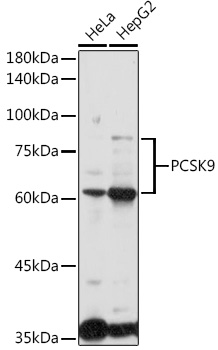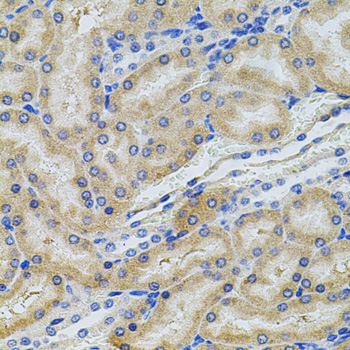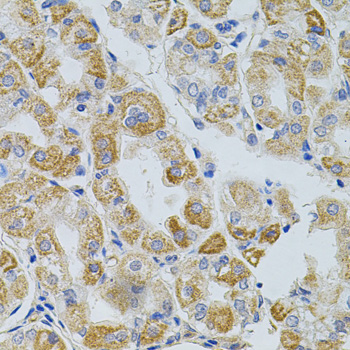Anti-PCSK9 Antibody (CAB7860)
- SKU:
- CAB7860
- Product type:
- Antibody
- Reactivity:
- Human
- Mouse
- Rat
- Host Species:
- Rabbit
- Isotype:
- IgG
- Antibody Type:
- Polyclonal Antibody
- Research Area:
- Cell Death
Description
| Antibody Name: | Anti-PCSK9 Antibody |
| Antibody SKU: | CAB7860 |
| Antibody Size: | 20uL, 50uL, 100uL |
| Application: | WB IHC |
| Reactivity: | Human, Mouse, Rat |
| Host Species: | Rabbit |
| Immunogen: | A synthetic peptide corresponding to a sequence within amino acids 600 to the C-terminus of human PCSK9 (NP_777596.2). |
| Application: | WB IHC |
| Recommended Dilution: | WB 1:500 - 1:2000 IHC 1:50 - 1:200 |
| Reactivity: | Human, Mouse, Rat |
| Positive Samples: | HeLa, HepG2 |
| Immunogen: | A synthetic peptide corresponding to a sequence within amino acids 600 to the C-terminus of human PCSK9 (NP_777596.2). |
| Purification Method: | Affinity purification |
| Storage Buffer: | Store at -20°C. Avoid freeze / thaw cycles. Buffer: PBS with 0.02% sodium azide, 50% glycerol, pH7.3. |
| Isotype: | IgG |
| Sequence: | CCHA PGLE CKVK EHGI PAPQ EQVT VACE EGWT LTGC SALP GTSH VLGA YAVD NTCV VRSR DVST TGST SEGA VTAV AICC RSRH LAQA SQEL Q |
| Gene ID: | 255738 |
| Uniprot: | Q8NBP7 |
| Cellular Location: | Cell surface, Cytoplasm, Endoplasmic reticulum, Endosome, Golgi apparatus, Lysosome, Secreted |
| Calculated MW: | 20kDa/74kDa |
| Observed MW: | 65KDa/80KDa |
| Synonyms: | PCSK9, FH3, HCHOLA3, LDLCQ1, NARC-1, NARC1, PC9 |
| Background: | This gene encodes a member of the subtilisin-like proprotein convertase family, which includes proteases that process protein and peptide precursors trafficking through regulated or constitutive branches of the secretory pathway. The encoded protein undergoes an autocatalytic processing event with its prosegment in the ER and is constitutively secreted as an inactive protease into the extracellular matrix and trans-Golgi network. It is expressed in liver, intestine and kidney tissues and escorts specific receptors for lysosomal degradation. It plays a role in cholesterol and fatty acid metabolism. Mutations in this gene have been associated with autosomal dominant familial hypercholesterolemia. Alternative splicing results in multiple transcript variants. |
| UniProt Protein Function: | PCSK9: Crucial player in the regulation of plasma cholesterol homeostasis. Binds to low-density lipid receptor family members: low density lipoprotein receptor (LDLR), very low density lipoprotein receptor (VLDLR), apolipoprotein E receptor (LRP1/APOER) and apolipoprotein receptor 2 (LRP8/APOER2), and promotes their degradation in intracellular acidic compartments. Acts via a non-proteolytic mechanism to enhance the degradation of the hepatic LDLR through a clathrin LDLRAP1/ARH-mediated pathway. May prevent the recycling of LDLR from endosomes to the cell surface or direct it to lysosomes for degradation. Can induce ubiquitination of LDLR leading to its subsequent degradation. Inhibits intracellular degradation of APOB via the autophagosome/lysosome pathway in a LDLR-independent manner. Involved in the disposal of non-acetylated intermediates of BACE1 in the early secretory pathway. Inhibits epithelial Na(+) channel (ENaC)-mediated Na(+) absorption by reducing ENaC surface expression primarily by increasing its proteasomal degradation. Regulates neuronal apoptosis via modulation of LRP8/APOER2 levels and related anti-apoptotic signaling pathways. Defects in PCSK9 are the cause of hypercholesterolemia autosomal dominant type 3 (HCHOLA3). A familial condition characterized by elevated circulating cholesterol contained in either low-density lipoproteins alone or also in very-low-density lipoproteins. Belongs to the peptidase S8 family. 2 isoforms of the human protein are produced by alternative splicing. |
| UniProt Protein Details: | Protein type:Secreted, signal peptide; EC 3.4.21.-; Protease; Secreted; Cell development/differentiation Chromosomal Location of Human Ortholog: 1p32.3 Cellular Component: Golgi apparatus; extracellular space; cell surface; rough endoplasmic reticulum; lysosome; endoplasmic reticulum; early endosome; ER to Golgi transport vesicle; extrinsic to external side of plasma membrane; perinuclear region of cytoplasm; cytoplasm; late endosome; plasma membrane Molecular Function:sodium channel inhibitor activity; very-low-density lipoprotein binding; protein binding; protein self-association; low-density lipoprotein receptor binding; serine-type endopeptidase activity; low-density lipoprotein binding; apolipoprotein binding; apolipoprotein receptor binding Biological Process: cholesterol metabolic process; lysosomal transport; apoptosis; positive regulation of receptor internalization; lipoprotein metabolic process; regulation of low-density lipoprotein receptor catabolic process; liver development; cellular response to starvation; proteolysis; neuron differentiation; protein autoprocessing; cholesterol homeostasis; triacylglycerol metabolic process; cellular response to insulin stimulus; neurogenesis; phospholipid metabolic process; positive regulation of neuron apoptosis; regulation of neuron apoptosis; negative regulation of receptor recycling; low-density lipoprotein receptor catabolic process; regulation of receptor activity; kidney development Disease: Hypercholesterolemia, Autosomal Dominant, 3 |
| NCBI Summary: | This gene encodes a member of the subtilisin-like proprotein convertase family, which includes proteases that process protein and peptide precursors trafficking through regulated or constitutive branches of the secretory pathway. The encoded protein undergoes an autocatalytic processing event with its prosegment in the ER and is constitutively secreted as an inactive protease into the extracellular matrix and trans-Golgi network. It is expressed in liver, intestine and kidney tissues and escorts specific receptors for lysosomal degradation. It plays a role in cholesterol and fatty acid metabolism. Mutations in this gene have been associated with autosomal dominant familial hypercholesterolemia. Alternative splicing results in multiple transcript variants. [provided by RefSeq, Feb 2014] |
| UniProt Code: | Q8NBP7 |
| NCBI GenInfo Identifier: | 317373487 |
| NCBI Gene ID: | 255738 |
| NCBI Accession: | Q8NBP7.3 |
| UniProt Secondary Accession: | Q8NBP7,Q5PSM5, Q5SZQ2, A8T640, C0JYY9, |
| UniProt Related Accession: | Q8NBP7 |
| Molecular Weight: | 20,827 Da |
| NCBI Full Name: | Proprotein convertase subtilisin/kexin type 9 |
| NCBI Synonym Full Names: | proprotein convertase subtilisin/kexin type 9 |
| NCBI Official Symbol: | PCSK9 |
| NCBI Official Synonym Symbols: | FH3; PC9; NARC1; LDLCQ1; NARC-1; HCHOLA3 |
| NCBI Protein Information: | proprotein convertase subtilisin/kexin type 9; subtilisin/kexin-like protease PC9; neural apoptosis regulated convertase 1; convertase subtilisin/kexin type 9 preproprotein |
| UniProt Protein Name: | Proprotein convertase subtilisin/kexin type 9 |
| UniProt Synonym Protein Names: | Neural apoptosis-regulated convertase 1; NARC-1; Proprotein convertase 9; PC9; Subtilisin/kexin-like protease PC9 |
| Protein Family: | Proprotein convertase subtilisin/kexin |
| UniProt Gene Name: | PCSK9 |
| UniProt Entry Name: | PCSK9_HUMAN |








